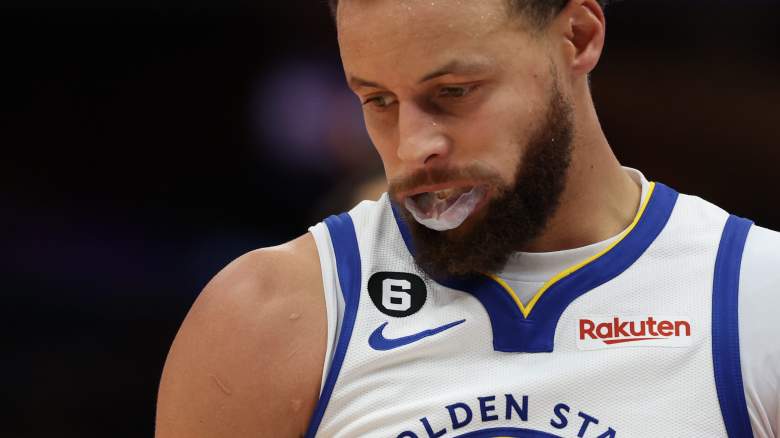
Getty Stephen Curry, Warriors
It was December of 2015 and the Warriors were having an off-day practice in a college gym next to Boston Common. I was there to speak with Steph Curry about Golden State’s brilliant 23-0 start to the season, a work opportunity that required patience.
The club went through its session in the small downstairs facility, and while most of the other Warriors chatted with the NBA media, Curry shot. And shot.
Around the 3-point arc he went, stopping at each of five stations — corners, wings and straight on — for 10 attempts. After completing the circuit, he’d reverse direction and do it again … and again.
Later, when the interview was complete and familiar salutations had been exchanged, Curry began to head off.
“By the way,” I said, turning back, “how many shots did you just get up, you know, AFTER the practice?”
“Two hundred and fifty,” he said in a manner so matter-of-fact that it took a while to marinate.
Eventually the pieces came together: The reigning MVP from the defending NBA champion had just dropped 29 on the Pacers and was at 52.9% from the floor for the season, with a 46.5% clip from 3. He was five games into an oddly-designed road trip that had begun 10 days earlier in Utah. He was already being hailed as perhaps the greatest long-distance marksman in history, and he’d shown no cognitive concerns to suggest he’d forgotten how to shoot on the flight from Indianapolis.
And yet: 250.
Much to Be Learned From Curry’s Approach
Turns out it was a bit of a slow day. According to assistant coach Bruce Fraser, who’s been Curry’s shooting chaperone for several years, the after-practice session usually lasts 300 to 500 attempts.
“That’s him. He’s a worker,” Fraser told Heavy Sports recently. “It used to even be more, but we’ve lessened it as the years have gone on, especially with the long playoff runs. It’s not crazy if you just watch the workout, because it’s pretty efficient. And he always finishes with 100 3s at the end of the 300-500.”
As for how many treys Curry will get up overall in the workout, “That’s dependent on what we decide to do that day. I would say he’s probably getting up a minimum of 200 3s each day,” Fraser said. “And then the rest could be whatever he wants — if it’s off a dribble or pick and roll or whatever.”
Certainly Steph Curry is not the only NBA player to put in a diligent effort, but he’s the only one who’s Steph Curry. And therein lies a lesson that should resonate with not only his peers but with everyone on down to those young players who this summer will be entering the transfer portal from sixth grade to seventh.
Those serious about the game and getting better might do well to consider that if this is what Stephen Curry believes he needs to do to achieve and maintain his level of play, perhaps younger stars in training may want to increase their personal routine.
For Stephen Curry Practice Builds Confidence
In a larger sense, it’s an example that has been around maybe as long as the game itself. Not that Larry Bird ever took aim at a peach basket or anything, but it’s not hard to find pictures of him as a solitary shooter in the old Garden well before any of his Celtic teammates had shown up for that evening’s game.
Curry isn’t breaking new ground. He’s simply continuing to strengthen the mind-body truth about the game. That is, players do not shoot well in pressure situations merely because they possess the physical talent to create sufficient distance from defenders and execute the act. There has to be, as well, a belief in oneself — and it can’t be faked. Your subconscious knows whether or not you’ve put in the work.
Thus, people like Curry don’t just HOPE their shot will find the strings when they rise up from 25 feet with a game on the line; hours of practice have embedded the mechanics on their computer chip, and in their soul they know they have earned the right to make this shot. Their lack of doubt is based in sweat.
“You’ve got to earn it,” said Fraser. “Absolutely. That’s all subconscious stuff that’s deeply rooted for when it’s needed. Steph’s confidence comes from the work he puts in and the results that he sees from the work.”
While millions watch Curry pull up from ridiculous distances to fling in 3-pointers in almost effortless fashion, they don’t necessarily realize the hours he spends in the gym when few bear witness.
“Who doesn’t realize that?” said his coach, Steve Kerr. “Fans? Like, everybody in the NBA knows how hard Steph works. His work ethic is legendary.
“If you know him or you know the team or you know the league, then you know how hard Steph works,” he told Heavy. “That’s why he’s so respected around the league. Otherwise people might take offense to some of the shimmies and the night-night stuff. But he works his ass off, and people respect that.”
Presented with the aforementioned clutch shooter theory, Kerr replied. “Earned confidence. Steph earns everything.”
The coach smiled when it was suggested he has some experience with the concept himself. Among the large shots he hit in his 15-year career was a certain game-winning 17-footer with five seconds left that clinched that clinched Game 6 and the 1997 championship for the Bulls.
“Yeah, but I wasn’t,” said 45.4% career 3-point shooter Kerr, his voice trailing off at the comparison to Curry. “I didn’t have that much confidence.”
But, like Steph Curry, as he made his way from youth leagues to the NBA, he knew where to find it.
